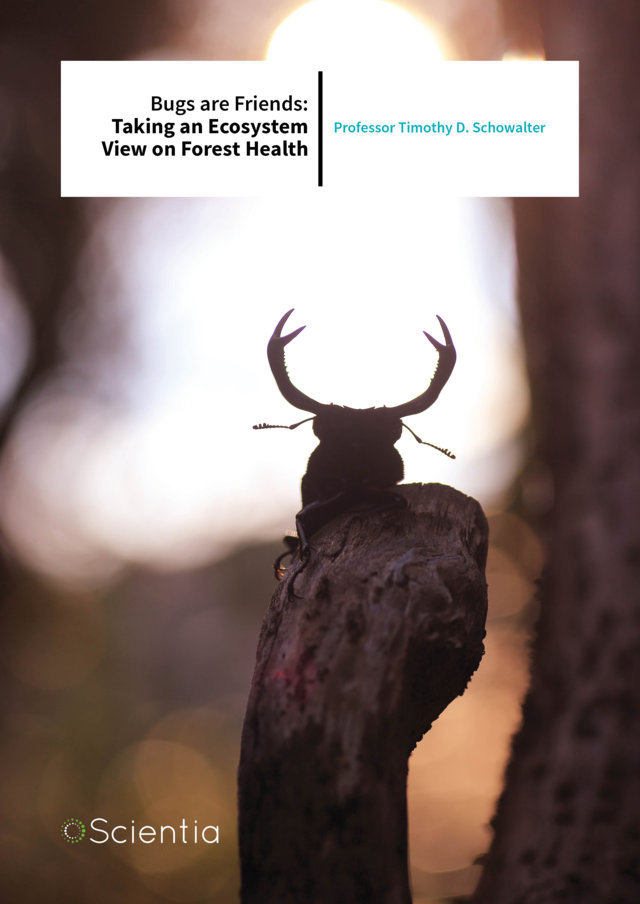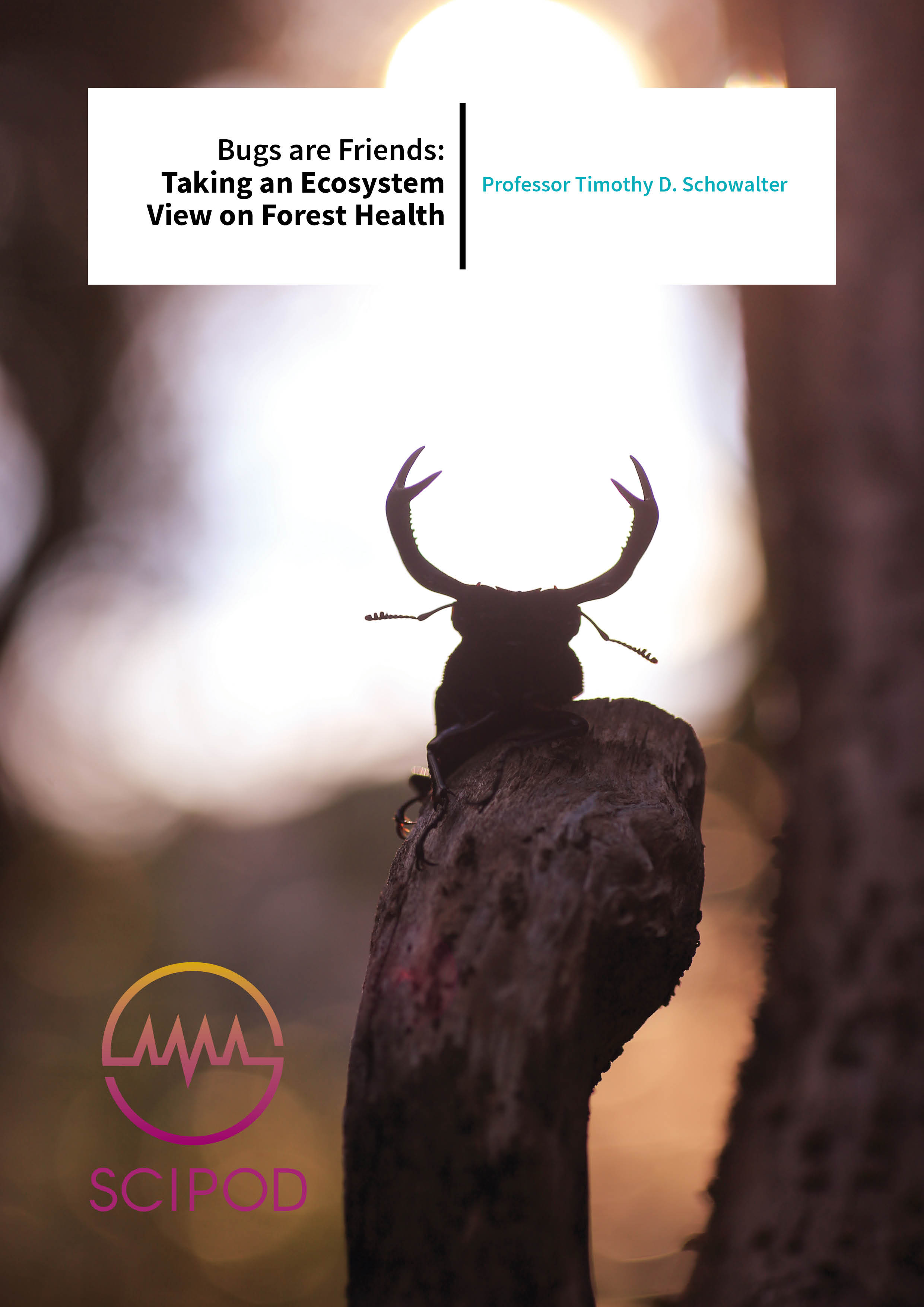Professor Timothy Schowalter – Bugs are Friends: Taking an Ecosystem View on Forest Health
Humans commonly view insects as unwanted nuisances, and many modern land-management practices focus on reducing insect numbers using toxic pesticides and invasive biological controls. Professor Timothy Schowalter at Louisiana State University has been studying insect communities for decades, and suggests that by working with insects in an ecosystem approach, we could enjoy healthier environments for years to come.
They Outnumber Us
Arthropods, the animal phylum including six-legged insects and their many-legged relatives such as spiders, are the most abundant type of animal life on Earth. Over one million arthropod species have been identified, but scientists estimate that there are between 10 and 30 million species currently living on Earth.
Arthropods are almost always viewed as pests, even though the majority are harmless to humans and much of our food supply depends on pollinators such as honeybees. Professor Timothy Schowalter at Louisiana State University has been studying arthropods over his lengthy career, and his research suggests that even species commonly viewed as pests can be healthy for ecosystems under the right conditions, and outbreaks should be viewed as symptomatic of larger management problems. He argues that when humans work with insect communities, rather than against them, we have much to gain.
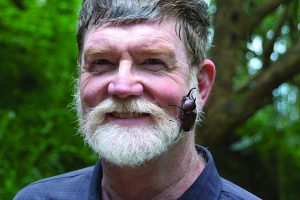
CREDIT: Professor Chow-Yang Lee (University of Malaysia)
Professor Schowalter’s work is driven by two main questions – how do arthropod communities respond to environmental changes, and how do changes in these communities alter ecosystem conditions and the ability of an ecosystem to deliver ecological services? To pursue answers to these questions, Professor Schowalter and his colleagues have engaged in large-scale arthropod diversity research projects in forests all over the world – from the chilly boreal conifer forests of northern latitudes, to the species-rich tropical forests of Puerto Rico. Their work has revealed new insights into how arthropods both respond to and drive changes within forests, and how humans can work with these abundant creatures to support healthy forests and ecosystems.
‘If insect pollinators and decomposers disappeared, humans would quickly notice that most fruits and vegetables would no longer be available, and plant and animal wastes would accumulate and probably bury us.’
The Living Forest
Understanding how arthropod communities respond to changes in a forest can help land managers understand how to keep forests healthy and thriving. Because of their small body size and environmental sensitivity, arthropods often act as early indicators of an ecosystem problem. Arthropod diversity is often used as a measure of the health of an ecosystem – particularly in the soil, where insect abundance and diversity are often more reliable measures of soil health than standard chemical assays.
Professor Schowalter and his team focus on insects living in the canopies of trees, and they have assessed arthropod diversity in many forests worldwide. One area of particular interest to the team is arthropod responses to tree harvesting methods in timber forests. The historical practice of ‘clear-cut harvesting’ – taking all the trees in an area at once – has had dramatic effects on forest ecology in the Pacific Northwest region of the United States and elsewhere, leading to declines in forest biodiversity and an increase in soil erosion. As an alternative, modern harvesting practices involve removing trees in gaps, clearing around clusters of older trees, and removing trees sporadically throughout a forest, while leaving some older trees evenly dispersed.
Professor Schowalter’s team compared the effects of these methods on canopy arthropod diversity in forests in Oregon and Washington, taking samples of arthropods a year before harvesting and once a year for two years after. They found that differences were minimal between treatments, but other studies in older forests treated in similar ways indicate that these differences grow more dramatic over time. The team’s results suggest that arthropods may be more sensitive to large scale changes than local events, though these effects must be tracked over time.
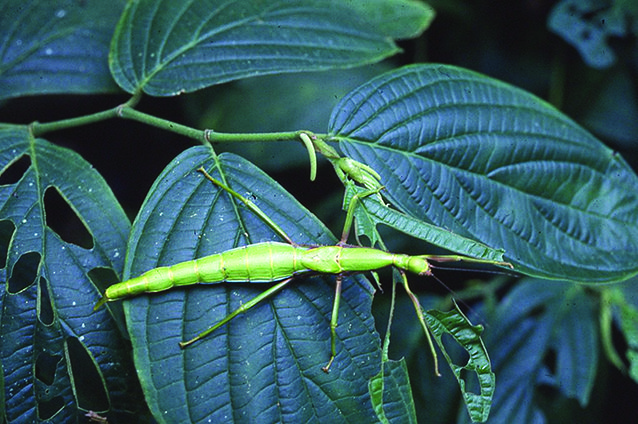
Professor Schowalter is also engaged in understanding the effects of the environment on arthropods in tropical forests. His team has been involved with the Luquillo Experimental Forest Long-Term Ecological Research Project in Puerto Rico for over 20 years, where they have been experimentally manipulating sections of forest, and observing arthropods’ natural responses to weather events such as hurricanes.
Using the resources of the Long-Term Ecological Research Project at Luquillo, the team’s experiments showed that the composition of arthropod communities fluctuates following a storm, and so they went on to investigate what storm factors contribute most to these fluctuations. The two major factors they were interested in were canopy openings and debris deposits. Canopy openings occur when many tall trees or branches fell in an area, allowing more sunlight and rain to reach the forest floor, while debris deposits are the leaves, twigs, and branches that fall off plants during a storm and end up on the ground. To replicate these conditions, the researchers created four forest plots – one untouched, one where they trimmed branches to create a canopy opening, one where they deposited debris, and one where they did both. While none of the arthropod groups in the forest responded to the canopy opening alone, nearly half of these groups showed changes in abundance in response to debris or the combined condition. This suggests that immediate biotic (living) factors, such as debris, lead to a more direct change than abiotic (non-living) factors, such as increased sunlight.
During Professor Schowalter’s time in Puerto Rico, his team has also observed insect responses to natural events – particularly the highly destructive hurricane Hugo in 1989 and Georges in 1998. Similar to their experimental results, the team found that about half of the studied arthropod groups responded strongly to storms, usually related to their niche in the forest. For example, insects that feed on detritus were most abundant immediately after a storm, while those that feed on tree sap surged in gaps when new growth emerged. They also found that when a group was severely reduced following a storm, they were unlikely to fully recover for many decades. ‘Some insect species can become very abundant, whereas others may decline or disappear, as a result of any particular change in environmental conditions,’ Professor Schowalter explains. Understanding how storms can impact biodiversity in forests grows more important as climate change increases the number and intensity of storms every year.
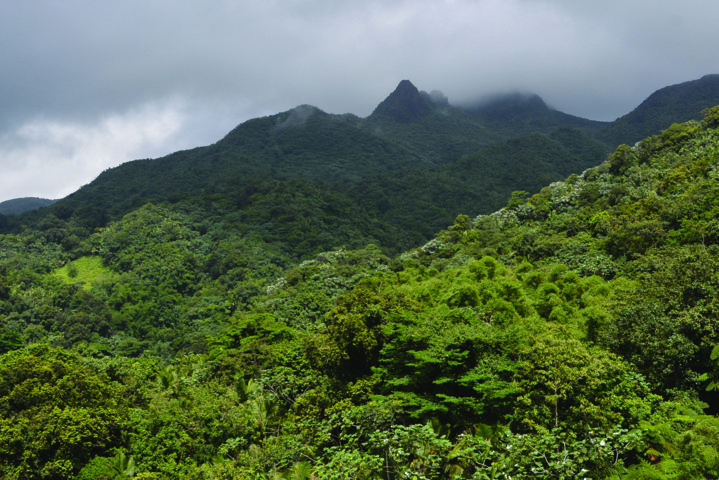
Unlikely Allies in Forest Management
Despite their bad reputation, many insects provide critical ecological services to their habitats that benefit humans, such as decomposition, pollination, prey for other animals, seed dispersal, and even herbivory. As decomposers, insects help to accelerate the breakdown of dead plants, plant parts and animals, helping to return organic nutrients to the soil. For example, burrowing insects like ants often carry organic matter deep into their nests and contribute to soil turnover, both of which lead to healthier soil that is better suited to grow plants. Pollinators are a critical component of plant life on earth – many plants cannot reproduce without pollinators and some plant–pollinator relationships are highly specific. For example, more than a third of our crop varieties depend on honey bees and other insects for pollination before a fruit or vegetable can be produced.
Insects also form an important food source for many other larger insects and animals, including humans. For example, salmon populations are supported by freshwater arthropods during their early years – thus, a healthy salmon population depends on a thriving arthropod population. Insects also operate as dispersal agents for other organisms, transporting seeds, fungal spores, and sometimes diseases. Ants are particularly important in this role, as they often carry seeds deep into the ground where they can begin to grow under ideal conditions. Many human societies acquire substantial portions of their protein from insects.
Insects also act as herbivores by eating portions of plants – an underappreciated ecological service. While excessive munching can be bad for a plant, research has found that many plants easily recover from a little nibbling, and in many cases, they are actually more productive after experiencing some herbivory. Some plants respond to an insect eating their leaves by investing more energy in their flowers and fruits, and this often benefits farmers’ yields more than the application of pesticides. In the majority of cases, working with arthropod communities actually benefits humans. As Professor Schowalter explains: ‘If insect pollinators and decomposers disappeared, humans would quickly notice that most fruits and vegetables would no longer be available, and plant and animal wastes would accumulate and probably bury us.’
He suggests that insects most often become problematic when the natural order of the forest is disrupted by human management practices. For example, outbreaks of the southern pine beetle can be devastating to pine groves, but primarily when these fire-adapted habitats have been fire suppressed or planted too densely by humans. Under natural conditions, the beetles only attack weak and ailing trees or those growing close together, decreasing resource competition for healthy trees and creating niches for other wildlife. However, in fire-suppressed forests and plantations, trees grow much closer together and the short-ranged beetle can multiply far beyond its normal capacity. Beetle outbreaks are more a symptom of poor management practices than a feature of the beetle itself. Similar issues are seen in monoculture farming practices – due to a lack of plant and arthropod diversity, insects that would normally be kept in check by predators, or the limited availability of suitable hosts, are able to easily jump from plant to plant, quickly consuming an entire field. ‘More diverse crop mixes and natural corridors for predaceous arthropods and birds have demonstrated the ability to reduce crop pests, whereas crop monocultures and agricultural intensification have the opposite effect,’ Professor Schowalter says.
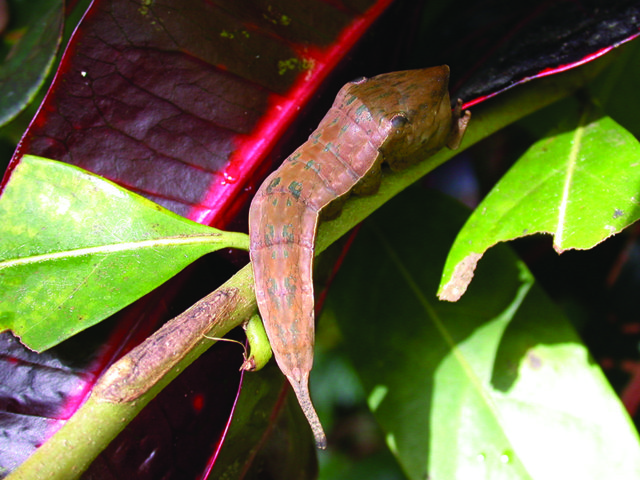
The team’s work in this area suggests that even herbivorous insects play a major role in maintaining healthy forests. In Puerto Rico, they sought to understand how common herbivore effects help to fertilise the soil. Herbivores alter nutrients in soil by dropping ‘greenfall’ (foliage fragments that fall as an insect chews through a leaf), creating faecal waste known as ‘frassfall’, and increasing rainwater’s ability to leech nutrients from leaves. The researchers simulated each of these conditions by enriching sections of the forest floor with only one of these substances and measuring changes in key soil nutrients over time. They found that frassfall created the most dramatic nutrient upticks and impacted other forest floor processes such as decay rates. Perhaps unsurprisingly, the team demonstrated that herbivorous insects are a critical component of maintaining nutrient availability in tropical forest soil.
In the temperate forests of North America, insects are equally important. Professor Schowalter has taken an interest in rare old-growth forests that often act as habitats for species not found in younger forests. These old forests maintain more stable temperatures and humidity, and feature more diverse plant life and habitat niches. They also seldom experience the insect outbreaks and other problems associated with younger groves, and are in many ways protected by their incredible biodiversity.
Old-growth forests contain more diverse arthropod communities that are just as critical for nutrient cycling through herbivory and decomposition as they are for pollination and prey. They represent the pinnacle of a healthy forest that self regulates, and are critical to protect, both for the preservation of biodiversity and so we can learn valuable lessons from observing them. Forest management officials save time and resources when they learn to work with insects to manage groves, rather than embark upon efforts to suppress them as unwanted pests.
However, Professor Schowalter points out that in some cases, insects will need to be managed or controlled in the short term. ‘For example, the droughts in western North America have stressed forests and led to catastrophic mortality due to fires and bark beetles, as a result of high vegetation density and fuel loads resulting from a century of fire suppression,’ he explains. ‘The warming and drying conditions of the region exacerbate the likelihood that if we let fire and insect outbreaks run their course, virtually all older forests could be burned. These forests, and others, need to be restored to conditions that were less prone to catastrophic wildfires and insect outbreaks. However, until these efforts make forests less vulnerable to fire and bark beetles, fire and insects will need to be managed to avoid catastrophic fires and outbreaks.’ By adapting our management practices, we can stop inducing these insect outbreaks and fires in the future.
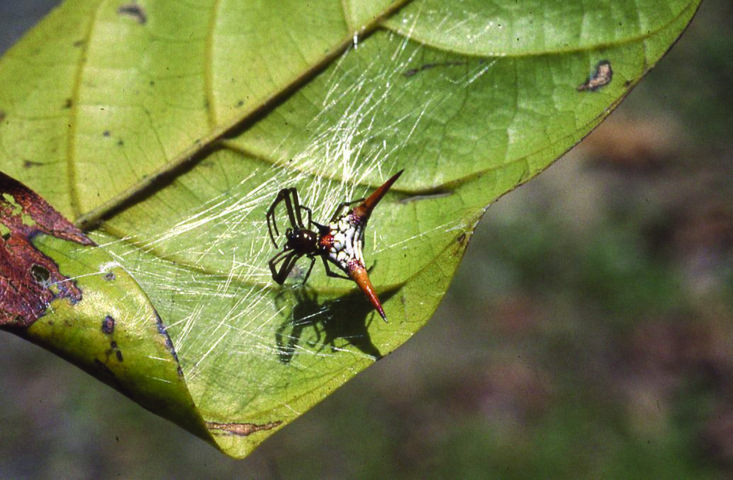
Lessons to Learn
Professor Schowalter’s work highlights the diverse and complex roles that arthropods play in building and maintaining healthy ecosystems. Far from pests, these tiny animals are critical members of forest communities that can teach us valuable lessons about taking care of the land if we pay attention.
Meet the researcher

Professor Timothy D. Schowalter
Department of Entomology
Louisiana State University
Baton Rouge, LA
USA
Professor Timothy Schowalter received his PhD in Entomology from the University of Georgia in 1979, following a BA in Biology and Anthropology from Wichita State University and an MS in Biology from New Mexico State University. He completed a post-doctoral position at Texas A&M University before joining the Department of Entomology at Oregon State University as an Assistant Professor in 1981, where he was eventually promoted to Professor and Interim Head. In 2003, he joined his current position with the faculty at Louisiana State University as a Professor of Entomology where he also served as the Department Head until 2015. Professor Schowalter is the author of four books, more than 70 peer-reviewed articles, and many book chapters and other publications. He served as Program Director for Ecosystem Studies at the National Science Foundation 1992–1993, as Vice President for Public Affairs for the Ecological Society of America (1999–2002) and as a Governing Board member for the Entomological Society of America (2013–present). He currently serves on the Editorial Boards for Frontiers in Ecology and the Environment and Journal of Economic Entomology, and was named a Fellow of the Ecological Society of America in 2012. His research focuses on insect responses to natural and anthropogenic disturbances, and the effects of these responses on ecosystem structure and function.
CONTACT
E: tschowalter@agcenter.lsu.edu
T: (+1) 225 578 1634
W: http://www.entomology.lsu.edu/schowalter.html
KEY COLLABORATORS
Steven Fonte, Colorado State University
Mike Willig, University of Connecticut
Jess Zimmerman, University of Puerto Rico
Grizelle Gonzales, USDA Forest Service, San Juan, Puerto Rico
Malcolm North, USDA Forest Service, Davis, CA
Dr Hang-Kwang Luh, Oregon State University
Dr Jung-Tai Chao, Taiwan Forestry Research Institute (retired)
Professor Wen-Jer Wu, National Taiwan University (retired)
FUNDING
U.S. National Science Foundation
USDA Forest Service
REFERENCES
T Schowalter, Arthropod Diversity and Functional Importance in Old-Growth Forests of North America, Forests, 2017, http://doi.org/10.3390/f8040097.
TD Schowalter, MR Willig and SJ Presley, Post-Hurricane Successional Dynamics in Abundance and Diversity of Canopy Arthropods in a Tropical Rainforest. Environmental Entomology, 2017, 46, 11.
TD Schowalter, MR Willig and SJ Presley, Canopy arthropod responses to experimental canopy opening and debris deposition in a tropical rainforest subject to hurricanes. Forest Ecology and Management, 2014, 332, 93.
TD Schowalter, SJ Fonte, J Geaghan and J Wang, Effects of manipulated herbivore inputs on nutrient flux and decomposition in a tropical rainforest in Puerto Rico, Oecologia, 2011, 167, 1141.
TD Schowalter, Y Zhang and RA Progar, Canopy arthropod response to density and distribution of green trees retained after partial harvest, Ecological Applications, 2005, 15, 1594.



